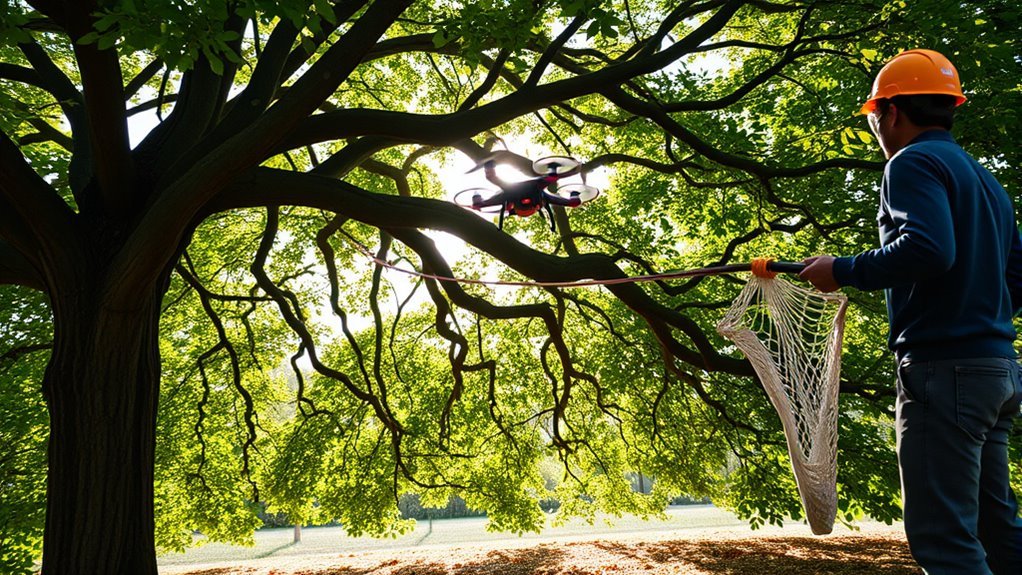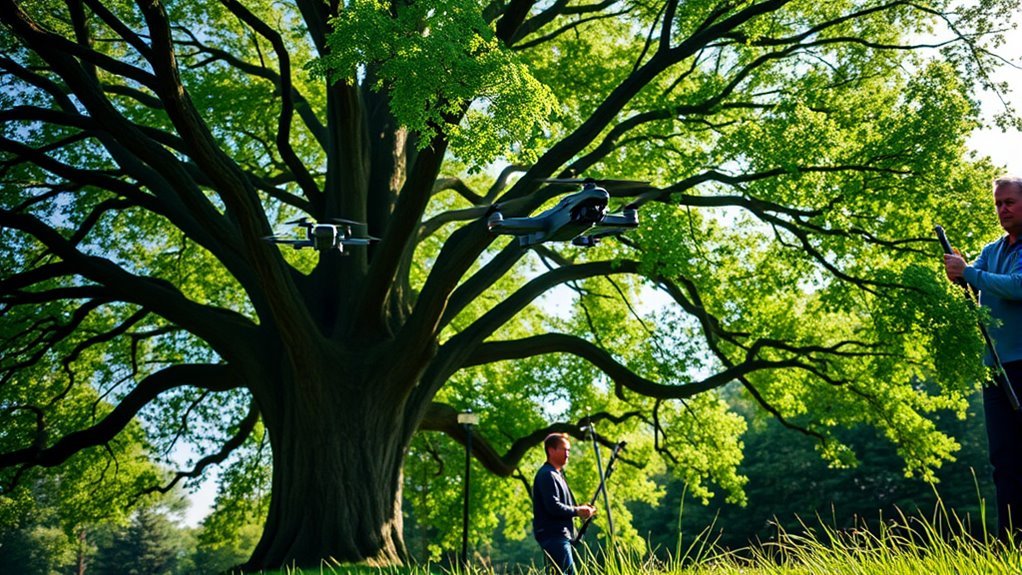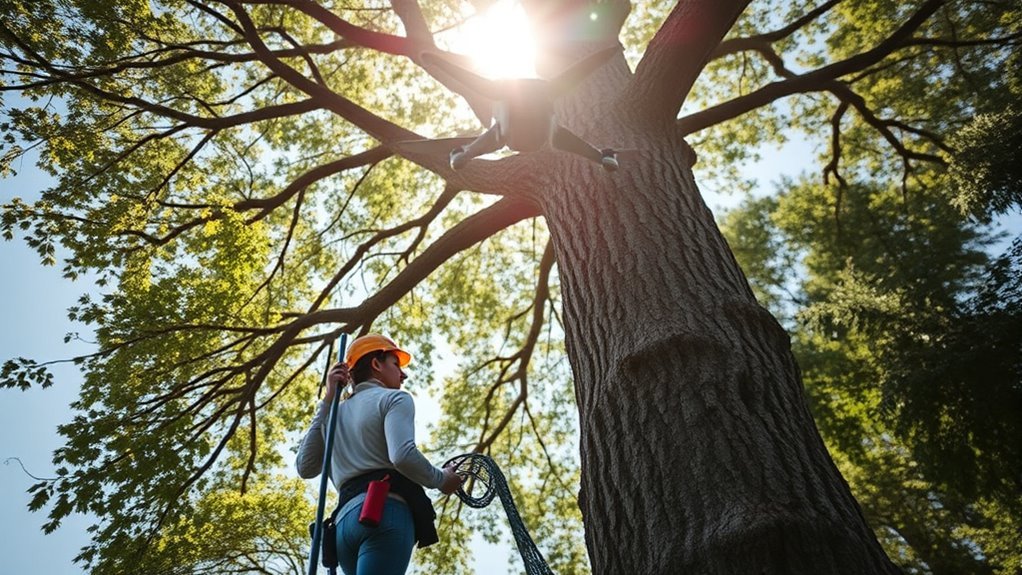To get your drone out of a tree safely, start by evaluating the situation for hazards and confirming stability. Gather necessary tools like a long reach pole and safety gear. Measure the tree height to plan your retrieval method. Use a long reach tool or carefully shake branches to dislodge the drone. If it doesn’t budge, consider using a weighted rope or calling for help. There are more effective strategies to guarantee a safe recovery ahead.
Assess the Situation

Before you attempt to retrieve your drone, it’s essential to assess the situation carefully. Start by observing the tree and its surroundings. Identify any potential tree hazards, like overhanging branches or unstable ground, which could pose risks during your retrieval. Make certain to evaluate the height of the drone and its position within the tree; this will help you determine the safest approach. Also, consider the weather conditions—wind can affect both your safety and the drone’s stability. Prioritize drone safety by making sure you’re not putting yourself in harm’s way. If the drone is entangled, think about how pulling it down might cause further damage. Taking these precautions will guarantee a safer and more effective retrieval process.
Gather Necessary Tools

Before attempting to retrieve your drone, you’ll need to gather the right tools. Make a checklist of essential items, including safety gear to protect yourself during the retrieval process. Consider various equipment options that can help you safely access your drone without causing further damage.
Essential Tools Checklist
When tackling the challenge of retrieving your drone from a tree, having the right tools on hand is essential to guarantee a safe and efficient recovery. Start with a sturdy extendable pole—this can help you reach your drone without climbing. A hook attachment is also useful for snagging the drone and pulling it down. If you’re considering climbing, make sure you have a reliable harness and climbing gear to prioritize tree climbing safety. A soft blanket or tarp can cushion the impact if the drone falls. Don’t forget a pair of scissors to cut away any entangled branches. These essential tools will equip you for effective drone recovery techniques, minimizing risks while maximizing your chances of success.
Safety Gear Importance
While retrieving your drone from a tree may seem straightforward, ensuring your safety is paramount. Before you climb or attempt to reach your drone, make sure you’re equipped with the right safety gear types. This protective equipment can help prevent injuries and keep your experience enjoyable. Here’s what you should gather:
- Safety helmet: Protects your head from falling branches.
- Gloves: Shields your hands from sharp objects and tree bark.
- Safety goggles: Keeps your eyes safe from debris.
- Sturdy footwear: Provides grip and support while climbing.
Taking these precautions helps you focus on retrieving your drone without worrying about potential hazards. Remember, your safety comes first, so gear up before you go!
Retrieval Equipment Options
Now that you’ve got your safety gear ready, it’s time to focus on the tools you’ll need to retrieve your drone from the tree. Consider using a long pole or a telescopic grabber, which can help you reach your drone without risking injury. If your drone’s stuck high up, a lightweight fishing net could also be effective. For added safety, avoid using any equipment that could cause further damage to the drone or the tree. Always prioritize equipment safety during your retrieval methods; don’t rush the process. If the situation feels beyond your control, calling a professional might be your best option. Remember, freeing your drone should be about reclaiming your freedom, not risking safety.
Determine the Height

To retrieve your drone, you first need to determine the height of the tree. Measure the tree’s height and assess where your drone is positioned within its branches. Using reference points, you can accurately gauge how far up your drone is stuck, which will guide your next steps.
Measure Tree Height
Before attempting to retrieve your drone from a tree, it’s essential to measure the tree’s height accurately. Knowing the height will help you decide the best approach to safely get your drone down. Here are some effective tree measurement methods you can use:
- Using a measuring tape: If you can safely reach the base, measure from the ground to the top.
- Estimating with a shadow: Measure the shadow length and use basic trigonometry to find the height.
- Using a clinometer: This tool allows for precise angle measurements to calculate height.
- Drone assistance: If you have another drone, fly it up to gauge the height.
Always adhere to drone safety guidelines while measuring to guarantee a secure retrieval process.
Assess Drone Position
Evaluating the drone’s position is essential for a successful retrieval. Start by determining how high your drone is lodged in the tree. Use your drone technology to estimate the height, whether it’s by visual assessment or using a laser rangefinder. Stand at a safe distance and look for branches that may interfere with your retrieval efforts. Remember, tree safety is paramount; you don’t want to risk injury while attempting to climb or use tools to dislodge your drone. If the drone is too high or entangled in difficult branches, it’s wise to reconsider your approach. Document the height and position before proceeding to plan your next steps carefully. This awareness will help guarantee a safe and effective recovery.
Use Reference Points
While evaluating your drone’s position, it is important to use reference points that can help you determine its height accurately. By doing this, you’ll better understand how to navigate the situation safely. Take a moment to identify your surroundings and use landmarks effectively. Here are some tips to guide you:
- Find nearby trees or buildings that can serve as height comparisons.
- Use a measuring tape or app to gauge distances from the ground to your drone.
- Observe the angle from where you’re standing to the drone; this can provide clues about its height.
- Record the height of the closest objects to maintain a consistent reference for future flights.
With these techniques, you’ll enhance your ability to assess and retrieve your drone safely.
Plan Your Retrieval Method
As you prepare to retrieve your drone from a tree, it’s essential to devise a clear and effective plan. First, assess the situation; determine how high your drone is and which branches obstruct it. Consider your drone retrieval techniques—whether climbing is viable or if you’ll need a long reach tool later. Prioritize tree climbing safety by ensuring the tree is stable and that you have the right gear, like a helmet and harness. If you decide to climb, familiarize yourself with the tree’s structure to avoid hazards. Remember to communicate your plan with someone on the ground, so help is available if needed. Take your time, and don’t rush the retrieval process—you’ll have your freedom back soon.
Use a Long Reach Tool
Using a long reach tool can be a practical solution for retrieving your drone without the need for climbing. However, tool safety is vital to avoid accidents. Here are some important considerations:
Using a long reach tool can safely help you retrieve your drone without climbing, ensuring tool safety is essential.
- Choose the right tool: Use a pole or grabber designed for reaching high places.
- Inspect your equipment: Verify your long reach tool is in good condition before use.
- Stabilize your stance: Maintain a solid footing to avoid losing balance while reaching.
- Follow a careful approach: Gently maneuver the tool to dislodge the drone without causing further damage.
Create a Safe Working Environment
Before you attempt to retrieve your drone, make certain to assess the surrounding hazards, like power lines or unstable branches. Wearing the proper gear, such as gloves and a hard hat, can protect you from potential injuries. Taking these precautions will guarantee a safer approach to getting your drone down.
Assess Surrounding Hazards
When retrieving your drone from a tree, evaluating surrounding hazards is essential to confirm a safe working environment. Take a moment to assess the area, focusing on potential risks that could endanger you or your equipment. Consider the following:
- Tree Stability: Confirm the tree is sturdy enough to support any movements you make while trying to retrieve the drone.
- Wind Conditions: Check for strong winds that could shift branches or your drone unexpectedly.
- Power Lines: Identify any nearby electrical lines that could pose a serious danger.
- Ground Obstacles: Look for uneven terrain or sharp objects that could cause injury if you need to climb or maneuver around the tree.
Use Proper Gear
Having the right gear can greatly enhance your safety and effectiveness while retrieving a drone from a tree. Before you start, make certain you’ve equipped yourself with essential drone gear, including a sturdy ladder or pole grabber. This’ll help you reach the drone without putting yourself in harm’s way. Always wear safety equipment, such as a hard hat and gloves, to protect yourself from falling branches or debris. If the tree is particularly tall or hazardous, consider using a harness for added security. Ascertain your footwear is non-slip to maintain stability while you work. By taking these precautions, you’ll not only improve your chances of retrieving your drone safely but also enjoy the freedom of flying again.
Try Shaking the Branches
Gently shaking the branches can sometimes dislodge your drone from its precarious perch. Before you proceed, consider the tree dynamics to avoid causing damage or injury. Here are some tips for shaking branches effectively:
- Assess the branch stability; only shake branches that seem robust.
- Use both hands for a firm grip, ensuring you maintain balance.
- Apply gentle pressure first; aggressive shaking might break the branch.
- Be mindful of surrounding obstacles, like other branches or power lines.
Use a Weighted Rope
A weighted rope can be an effective tool for retrieving your drone from a tree. Start by selecting a sturdy rope with a weight attached to one end; this will help you throw it higher and more accurately. Use weighted rope techniques to aim for branches above your drone, ensuring you don’t hit the drone itself. Once the rope is entangled in the branches, gently pull to dislodge the drone. Be cautious not to apply too much force, as this could cause damage. Employing these drone retrieval strategies can increase your chances of success. Remember, patience is key; take your time to assess the situation before attempting to retrieve your drone. Happy flying!
Consider Calling for Help
If you’re struggling to retrieve your drone from a tree, don’t hesitate to call for help. Sometimes, professional assistance is the safest option. Whether it’s drone services or local experts, reaching out can save you time and potential damage. Here are some things to weigh:
- Experience: Professionals have the skills required to safely navigate tricky situations.
- Safety: Avoid risking injury by attempting dangerous retrieval methods alone.
- Equipment: Experts often come equipped with tools designed specifically for drone recovery.
- Efficiency: Professionals can usually retrieve your drone faster, allowing you to get back to flying.
Prevent Future Incidents
To prevent future incidents of your drone getting stuck in a tree, it’s crucial to assess your flying environment before each flight. Always check for tall trees and obstacles in your vicinity. If you regularly fly in areas with overgrown branches, consider tree trimming to create a safer space for your drone. Additionally, stay updated with drone maintenance; verify your propellers are in good condition and your battery is charged. This can help you maintain better control and avoid unexpected crashes. Furthermore, understanding real-time flight adjustments can enhance your response to unexpected environmental changes while flying. Make sure to review local regulations to ensure you are flying in compliance with the law. Finally, practice flying in open spaces until you’re comfortable with your drone’s capabilities. By taking these precautions, you can enjoy the freedom of flying while minimizing the risk of getting your drone stuck again.
Frequently Asked Questions
How Can I Prevent My Drone From Getting Stuck in Trees?
To prevent your drone from getting stuck in trees, practice careful drone flying and improve your tree navigation skills. Always maintain awareness of your surroundings, and avoid flying too close to tree branches or dense foliage.
What Should I Do if the Drone Is Damaged After Retrieval?
If your drone’s damaged after retrieval, start with a thorough damage assessment. Document any issues and research drone repair options. Depending on the extent of damage, you might need professional help or can attempt repairs yourself.
Are There Any Legal Considerations for Retrieving a Drone From a Tree?
When retrieving your drone, consider local drone regulations and tree ownership. Trespassing on private property can lead to legal issues, so make certain you have permission before attempting to recover your drone from someone else’s tree.
Can I Use a Ladder to Get My Drone Out of a Tree?
Using a ladder for drone retrieval can be effective, but prioritize ladder safety. Make certain it’s stable, and never overreach. Always assess the risk of falling or damaging your drone during the retrieval process.
What Type of Insurance Covers Drone Retrieval Incidents?
For drone retrieval incidents, liability coverage in your insurance policy might help. However, check your policy limitations, as many do not cover damage or loss during retrieval efforts. Always review your terms before flying.

